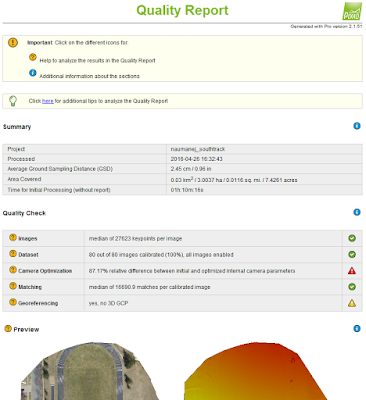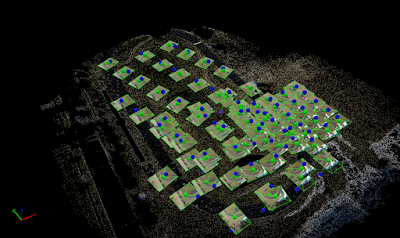Navigation with a GPS device using a UTM coordinate system
Field Activity #12
Introduction-
This field activity was a follow up from field activity #3 which the class was asked to create a map that could be used to located points of interest. Two main factors came into play when creating the map used for this activity, the coordinate system and the projection. To be able to successfully locate the points on the map it had to be in a UTM coordinate system. Our group was unfortunate with the map we used as it was in a Transverse Mercator projection. This would cause for problems with trying to locate our points on the map before finding them. By not being able to have a general sense of direction based on the map, our group had to rely on the GPS unit to navigate through the woods to locate our points.
To get a general sense of direction of our points, we used trial and error. By looking at the coordinates on the GPS device and cross referencing them with the coordinates for our course, we new that we had to be located in the southeast quadrangle of the course. Figure 1 shows the map that we used to give a sense of direction for our group. One major thing that would be nice to show on the map would also be the trails that wind throughout the wooded area. This would allow for much easier walking four our group as we were on a very steep hill for roughly half our coordinates.
 |
| Fig. 1 is of the map that was used to give a sense of direction during this activity. |
Methods-
Our group was assigned five different coordinates that we were asked to find. The first coordinate was located in a very hilly region of the priory that was difficult to get to and find. Basing our navigation only off of the GPS device, we were winding back and fourth through the woods trying to get a bearing on the first point. After getting a direction established to go in, we ended up spacing ourselves out in a line allowing us to cover more ground to spot the point we needed. We knew that we were looking for a ribbon on a tree that would mark our first point. As our group continued along through this hilly environment, we realized that this was much harder due to the thick vegetation that we were experiencing. This would have been the point were we could have used the trails through the woods, if they were located on our map, to make travel much easier. Figure 2 shows the first point we found. As we were walking through the woods we were expecting to see a standing tree with a bright ribbon on it to make it easy to locate. This was not the case as this first point was an old tree that had been blown over and was laying on the ground making it difficult to see the ribbon.
 |
| Fig. 2 the first coordinate system attached to the fallen down tree. |
As we continued on with our coordinates and points to find, we began to gain a better understanding for trails running through the woods and how to utilize them to help find the remaining points. Our second coordinates were only located a few hundred meters from our first point, so we knew that we were in the general area. By using a few trial and error direction techniques based on the GPS location, we knew the direction we had to continue on for our second point. Figure 3 shows the location of our second point that we had found.
 |
| Fig. 3 is the location of our second point that we found. |
One mistake that we made was not being able to recognize that it would have been easier and less time consuming to find our third point before our second point as the third point was actually located closer to the first point. After realizing this we made sure to not make the same mistake again as this would be the case for points 4 and 5. The second point was located at the bottom of the steep hill that was home to the first point. This second point was located to the southeast from the first point roughly 200 meters away.
 |
| Fig. 4 is the location of point 3 located next to a busy road. |
Figure 4 shows the location of our third point. This point was only 100 meters from the first point due east as this point would have been much easier to go to after the first point rather than backtracking from the second point. The third point was located near the highway as we could see the road and hear the cars humming by. By referencing back to our map (figure 1), we new that we were in the lower southeast corner of our map and almost out of room to the edge of the priory. We knew that we were going to be headed in a northwestern direction as all the points were located inside the priory.
Figures 5 and 6 show the remaining two points that we were asked to find in our group. After locating the location of the third point, we realized that the fifth point was actually closer to point three then point four was. From learning from prior experience with points two and three, we decided that we would go find the fifth point first. This would allow us to save time finding these last two points. By gaining a bearing in a northwestern direction from the third point while using the GPS, we realized that the fifth point was also at the bottom of this large ridge. Seeing as we were already on the bottom of this ridge and in a stand of pines that were lined in rows, the travel to this fifth point was relatively easy. This fifth point was at the bottom of this ridge, but was also at the top of another drop off. Before finding this point, we actually went down into this ravine thinking that the point was located at the bottom. Big mistake as it was only buckthorn and other prickly vegetation located down here. As we climbed our way out we spotted the fifth point. Figure 6 shows the location of the fifth point that we found.
As we only had one point left, point 4, we knew that we were coming to an end. We actually found this point in the very beginning after point two as we were wandering through the woods but failed to realize it as it wasn't the point we were looking for. Knowing the location of this point and knowing that a trail lead directly to it, we knew the direction that we had to travel. We hardly used the GPS to find this point until we actually came across this point. As we came to this point, we marked it on the GPS and headed back to the parking lot of the priory. Figure 5 shows the location of this fourth point.
 |
| Fig. 5 shows the location of the fourth point while we are reading and gaining a bearing. |
 |
| Fig. 6 shows the location of the fifth point, but we found this point before point 5. |
After completing the collection of all the points and saving them as we collected them on the GPS, the next step would to put these points on a map that would make sense. Before we started collecting the points in the field, we put a tracker that would plot points as we traveled with the GPS. This would show the areas that we covered while finding our points. Although the tracker would only collect points every 2 meters, we were able to use a tool that could convert these points into lines. The tool that was used was the point to line tool. It's a very easy tool to convert points into lines. Figure 7 shows the map we used along with the route that we traveled to find the points as well.
 |
| Fig. 7 Shows a track of the area that was walked during the field activity |
Summary-
As this activity was a spin off from activity three, there was nothing we could do about the coordinate system anymore that our map was in. In the third activity two maps were actually made, one in the transverse mercator coordinate system and one in the UTM system. Unfortunately the wrong map was printed off for this activity, causing much confusion and made us rely only on the GPS device. Although we were able to find all of our coordinates for this activity, it would have been much easier if we had access to the right map. This would have allowed us to gain a location of the points within 15 meters without even using the GPS device. One thing good about the map we did use however was that it showed the different elevation changes of the priory. If we would have had the elevation change and the right coordinate system, we would have been able to pick easier routes of travel to find the points. Although we didn't have the correct map, our group was able to communicate and work together to establish a system that would allow us to find the points. Without the group working together this would have been a very hard activity for one person to figure out on their own.












